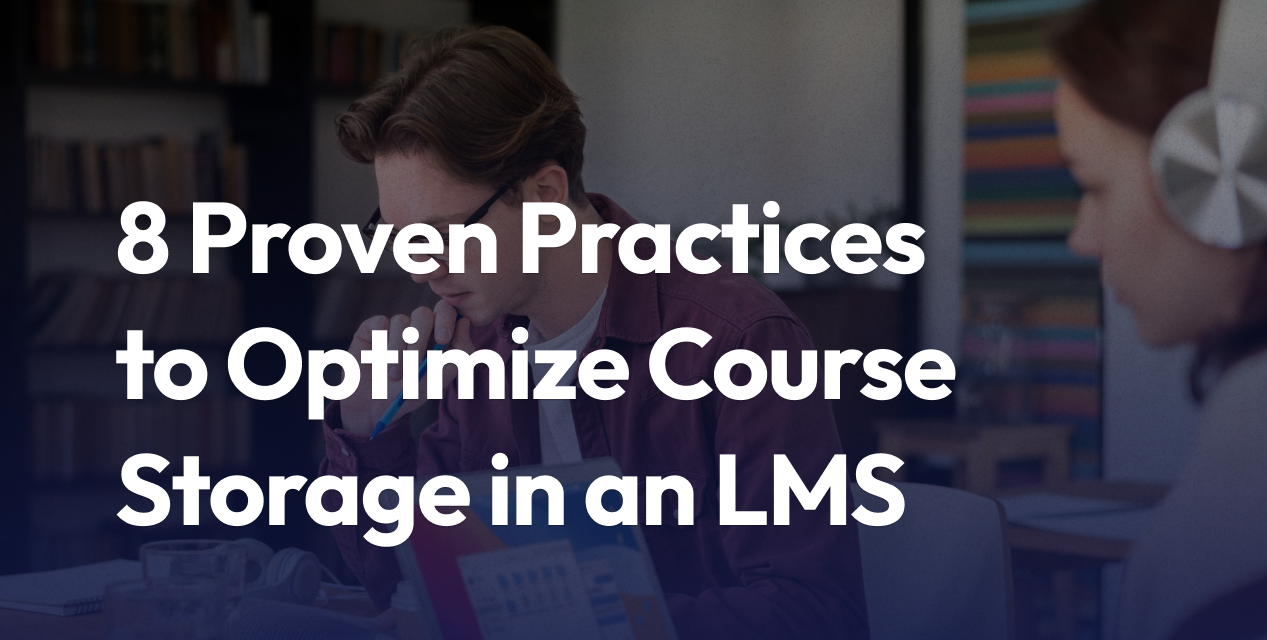
8 Proven Practices to Optimize Course Storage in an LMS
A streamlined, cost-effective LMS starts with smart storage. This guide shows eight practical ways to clear clutter, reclaim space, and keep courses organized—so pages load faster, bills stay lower, and admins spend more time on learning, not file wrangling.
You’ll learn how to:
- Monitor storage and automate monthly/quarterly audits
- Set clear policies: formats, sizes, retention, and quotas
- Archive inactive courses to keep dashboards clean
- Offload large media to external/cloud services and embed
- Compress videos/images and remove duplicates
- Purge outdated/unused content on a routine cadence
- Use analytics/reporting to find space hogs quickly
- Align storage plans with your LMS provider for scalable growth
If you want more ways to streamline your LMS, check out other practical tips and feature highlights in our related guide:
Why Optimizing LMS Course Storage Matters
Efficient storage management in your Learning Management System (LMS) is about more than saving space. Every video, PDF, and quiz takes up a bit of your system’s overall performance potential. If content is disorganized or if old, unused files continue to accumulate, your LMS slows down, costs rise, and your team spends more time addressing issues than creating value for learners.
When course storage is tight and cluttered, everyone suffers. Admins face headaches finding or updating resources. Instructors wait longer for uploads. Students experience slow loading and broken content. Cloud hosting bills creep higher because forgotten files live rent-free.
Taking time to optimize your LMS course storage fixes these issues before they become daily frustrations. You free up resources, lower costs, and keep your platform responsive for everyone involved. Think of storage optimization like spring cleaning: you sort what’s needed, clear out the mess, and set up better systems so clutter never takes over again.
By putting smart storage strategies into practice, you set yourself up for a smoother operation. Team members work faster with less confusion, students get reliable access, and your LMS can easily scale as your audience grows. The next sections outline eight practical ways to keep your course storage lean and efficient without sacrificing quality or usability.
Want more ways to streamline your LMS?
Modern LMS platforms can quickly feel cluttered. Files pile up, courses balloon in size, and soon your storage is packed with materials no one uses anymore. If your admins and instructors feel like file managers instead of educators, it’s time for smarter strategies. Some simple tools and habits can make cleanup almost automatic and put you back in control.
Looking for fresh ideas to keep your LMS efficient? Take a look at easy but effective options below to help your courses load faster, cut clutter, and sidestep surprises on your next hosting bill.
Take Advantage of Smart Metadata
Attaching metadata to your files—like subject, course code, or expiration date—makes tracking easier and automated cleanup practical. When you can sort files by age, owner, or category, it takes seconds to find what should be archived or deleted. Many LMSs let you filter by tags, so you can spot outliers that inflate your storage stats without providing value.
Best practices for using metadata in your LMS:
- Add clear, descriptive tags to every new upload.
- Standardize naming (think: “Chemistry101_Spring2024_LabGuide.pdf”) for easy batch processing.
- Use automation tools to auto-tag or expire old files, making regular purges a breeze.
Encourage Media Offloading
Uploaded videos and high-res images are the main space hogs inside most learning platforms. Instead of storing these files directly in your LMS, use third-party video hosting like YouTube or Vimeo for media, and embed the links in your course pages. This keeps your LMS lean while still giving learners a seamless experience.
What are the benefits?
- Video hosting platforms optimize streaming and reduce load on your LMS.
- You free up substantial storage space for course essentials.
- Backups run faster and require less cloud storage.
Automate Storage Audits
Manual cleanups work once, but a better strategy is setting up recurring storage audits. Use your LMS’s built-in reporting tools to review what’s taking up the most space on a monthly or quarterly basis. Many systems come with dashboards or usage notifications that flag outdated or duplicated resources.
Try these steps to automate your storage health checks:
- Schedule regular reports on file and course sizes.
- Set alerts for unused or inactive files crossing a certain age threshold.
- Act on audit results with team clean-up sprints or by using built-in bulk delete options.
Staying ahead of storage limits makes your courses more reliable for your team and learners. If you want to further reduce admin work and keep focus on what matters most—teaching and learning—keep exploring ways to streamline your LMS.
8 Proven Practices to Optimize Course Storage in Your LMS
Keeping your LMS organized and running smoothly starts with smart storage habits. The following best practices help you stay ahead on space, avoid messy course libraries, and set clear guidelines for everyone involved. Whether you manage a handful of online modules or a catalog of hundreds, these steps make it easier to keep clutter out and performance up.
Monitor Course Storage Regularly
Staying aware of your storage use helps you avoid last-minute scrambles. Most LMS platforms include dashboards or reports tracking storage consumption by course, file type, or user. Set up automatic alerts for when you’re nearing key storage limits. By reviewing dashboards weekly or monthly, you’ll spot courses or resources that balloon in size, letting you act before running out of space. Routine checks take little time and save you from sudden performance drops or surprise bills.
Set Storage Limits and Internal Policies
Clear storage policies prevent confusion and keep your LMS tidy. Document rules about:
- What types of content can be stored
- Accepted file sizes and formats
- How long should content remain active
- Who manages regular cleanups
Communicate your policies to all instructors and admins in team meetings or onboarding guides. Reinforce them inside your documentation or through quick reminders in internal newsletters. Make enforcement easy by setting user quotas and access rights in your LMS.
Archive Old or Inactive Courses
Archiving lets you declutter the main LMS without losing valuable historical content. Move completed or inactive courses to an archive folder or export them to reliable external storage. This approach reduces noise when searching for current material while keeping old lessons retrievable if questions arise. Your main dashboard stays clean, and critical records remain backed up and compliant.
Store Large Files Externally
Videos, high-resolution images, and audio files eat up storage quickly. Use secure cloud storage services like Google Drive, Dropbox, OneDrive, or specialized media platforms. Store large files externally, then link or embed them in your courses. This not only reclaims LMS space but also improves upload and download speeds for both instructors and students.
Optimize File Size and Course Content
Reliable courses don’t need to be heavy. Keep storage lean by:
- Compressing videos before upload
- Reducing image sizes without sacrificing quality
- Removing duplicate or outdated files
- Encouraging the use of PDFs, slides, and lightweight formats
Small improvements in file size add up, especially for large classes. Tools like HandBrake (for video) or TinyPNG (for images) make this step simple and effective.
Delete Unused or Outdated Content Regularly
Old quizzes, duplicate assignments, and outdated course materials drain storage and slow down searches. Schedule routine cleanups—monthly or at each term’s end. Make it a team habit to clear out expired content, adjust quizzes, and remove files that are no longer needed. A tidy library lets users find what they need quickly and streamlines future updates.
Collaborate with Your LMS Provider on Storage Planning
Open a line with your LMS provider to discuss your current and future storage needs. Most LMS vendors offer tools, upgrades, or advice to help manage space. Explore options like expanding your storage quota, turning on advanced analytics, or using built-in archiving features. Providers can point you toward solutions tailored for the way your team works and grows.
Use Storage Analytics and Reporting Tools
Deep dives are not just for technical teams. Most platforms now include analytics and reporting dashboards that map how storage is used. Review these reports to identify trends, large files, or courses that need attention. Make decisions on what to keep, archive, or delete based on hard data, not guesswork. Better analytics equals smarter storage choices every semester.
Looking for more guidance on what to expect from an effective learning system? Learn about essential LMS features every training platform should have to set your team up for success.
Final Steps and Expert Help: Optimize Your LMS for Speed and Savings
You’ve put smart storage habits in place, but the last push toward true optimization comes when you focus on speed and cost efficiency. Fine-tuning your LMS helps every user, from course creators to students, see the difference in faster load times, smoother uploads, and fewer budget surprises. Wrapping up your workflow with strategic reviews, performance tweaks, and outside expertise keeps your learning platform performing at its best.
Complete a Speed Health Check
Run a review of your LMS speed at the end of major updates or cleanups. Look for pages or courses that still load slowly and make a note of where delays happen. This is often tied to oversized media, unused plugins, or bloated courses. By checking the performance right after cleaning, you catch lag before it impacts your users.
Practical ways to speed up your LMS:
- Remove or update slow add-ons and plugins.
- Optimize course landing pages to feature only active, necessary materials.
- Compress any overlooked images or videos that might drag down performance.
- Schedule regular times to monitor load speeds for core courses.
These targeted checks save you future headaches and keep your platform feeling fresh for every login.
Optimize Cloud and Hosting Plans
After you’ve cleared out old files and slimmed down courses, check your LMS hosting or cloud plan. Are you paying for more storage or performance than you use? If your cleanups have made room, consider downgrading storage tiers to save costs. On the flip side, if your user base grows quickly, consult your provider about flexible scaling options to match demand without losing speed.
Quick savings come from:
- Matching your plan to current storage needs.
- Setting up auto-scaling with your hosting provider.
- Using monitoring tools to prevent surprise overage charges.
Combining storage management with the right hosting plan protects your budget and delivers better speed for everyone.
Schedule Ongoing Maintenance
One-off fixes help, but regular upkeep is key. Set a maintenance schedule that focuses on reviewing large files, outdated material, and the storage analytics built into your LMS. Assign responsibilities so team members know who will run checks, archive finished courses, and handle needed changes.
A reliable maintenance plan leads to:
- Quicker recovery from storage or speed issues.
- Fewer disruptions for course authors and students.
- Predictable platform performance across every semester.
Keep your documentation clear, make checklists, and create reminders on your team calendar to push these tasks forward.
Bring in Expert Guidance
Sometimes you reach a limit on what internal teams can handle alone. This is where expert consultation makes a real difference. Dedicated LMS experts can analyze your system for hidden issues, recommend advanced performance tweaks, and help you build workflows that save both time and money.
If you want deeper insights or step-by-step support, consider using professional services like LMS consulting from experts. Specialists can manage everything from migration to automation, ensuring your LMS is streamlined for speed and storage.
Investing in a few hours with an expert can deliver results that pay off for years.
Table: Key Actions for Maximizing LMS Speed and Savings
| Final Optimization Step | Why It Matters | Who Should Act |
|---|---|---|
| Speed Health Check | Quickly spot and fix slowdown areas | Admins, IT Support |
| Align Cloud/Hosting to Needs | Lower costs, avoid overpaying | Admins, IT Finance |
| Ongoing Maintenance Scheduling | Keeps performance steady over time | Admins, All Teams |
| Expert Consultation | Unlocks advanced fixes, saves time | Team Leaders |
We’ll help you optimize storage, hosting, and performance for a faster, leaner LMS.
Frequently Asked Questions
Q: How Often Should We Clean Up Course Storage?
You should schedule routine cleanups at least once per term or quarter. Frequent storage checks help avoid surprises, ensure faster course loading, and keep your content library up to date. By building cleanup into your academic or business calendar, you’ll make it a habit rather than a last-minute scramble.
Q: What Types of Files Take Up the Most Space?
The main culprits are usually:
- Videos: High-definition lecture recordings or tutorials use the most space.
- Large PDFs and Presentations: Especially scanned books or image-heavy slides.
- Audio Files: Podcasts or voiceover materials, if not compressed.
- Raw Images: High-resolution graphics from stock photo sites or course photographers.
By identifying these resource types, you can focus your efforts where they matter most.
Q: Is It Okay to Delete Old Courses and Content?
Absolutely, as long as they are no longer needed for reference or compliance. Before deleting, review your organization’s retention policies and confirm with course owners. Many LMS platforms offer archiving, which is safer for storing content you may need again. Archiving keeps your main dashboard clear while making past materials easy to restore.
Q: How Can Course Instructors Help With Storage Management?
Course instructors play a key role by:
- Keeping course files organized with clear names and proper tags.
- Removing duplicate or outdated resources each term.
- Compressing and resizing large media files before uploading.
- Following storage guidelines shared by the admin or IT team.
Training instructors on storage best practices leads to a tidier and more efficient LMS.
Q: What Happens If Our LMS Storage Quota Is Reached?
When you hit your storage limit, you may face:
- Blocked uploads or error messages when adding new files
- Slower performance for all users
- Extra charges on your monthly or yearly LMS bill
Avoid these headaches by monitoring usage and setting up alerts in advance. If you’re growing fast, contact your LMS provider early to discuss expanding your storage or archiving old materials.
Q: Should We Use Third-Party Storage Services?
Using external services like Google Drive, Dropbox, or video hosting sites makes a big difference for large media files. You can then embed or link these resources inside your LMS, freeing up space for critical documents and course content. This simple step can extend the life of your current plan and keep your LMS running reliably.
Q: How Do We Ensure Data Security When Managing Storage?
Always check that your LMS and any external storage solutions comply with your organization’s privacy and security policies. Use secure passwords, encrypted connections, and access controls to limit who can view, upload, or delete files. Regular backups are essential for protecting valuable learning materials.

